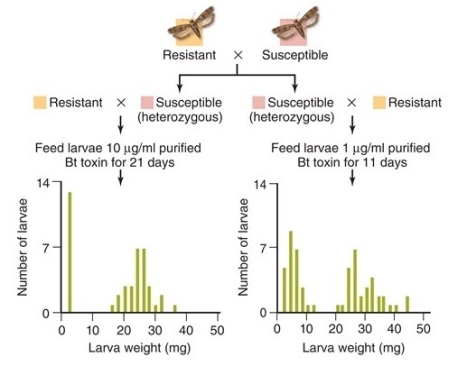A) homologous.
B) heterozygous.
C) homozygous.
D) dominant.
E) recessive.
G) B) and C)
Correct Answer

verified
Correct Answer
verified
True/False
Genotypes are the outward expression of an allele combination.
B) False
Correct Answer

verified
Correct Answer
verified
Multiple Choice
Adult female bollworm moths lay eggs on cotton bolls.These eggs then hatch and grow into caterpillars that eat the seeds of the boll.The eggs and sperm are produced by
A) meiosis.
B) mitosis.
C) fertilization.
D) crossing over.
E) mutation.
G) B) and E)
Correct Answer

verified
Correct Answer
verified
True/False
If X inactivation fails,this is a good thing as it is an error of meiosis.
B) False
Correct Answer

verified
Correct Answer
verified
Multiple Choice
Recessive alleles seem to vanish in some generations and reappear in later generations because they
A) cannot be expressed in males.
B) are masked by a dominant allele.
C) cannot be expressed in females.
D) cannot be expressed in successive generations.
E) are lost by mutation.
G) B) and C)
Correct Answer

verified
Correct Answer
verified
Multiple Choice
Which gametes can a RRyy plant produce?
A) RR or yy
B) Ry
C) RY or ry
D) RRyy
E) R or y
G) A) and E)
Correct Answer

verified
Correct Answer
verified
Multiple Choice
In these data, the parental generation characteristics (resistant or susceptible) are shown at the top.
 -In this figure,the genotype of the resistant parental bollworms is ________ while the susceptible parental bollworms have a ________ genotype.
-In this figure,the genotype of the resistant parental bollworms is ________ while the susceptible parental bollworms have a ________ genotype.
A) rr; RR
B) RR; rr
C) Rr; rr
D) RR; Rr
E) Rr; RR
G) C) and D)
Correct Answer

verified
Correct Answer
verified
Multiple Choice
When Mendel crossed short (tt) pea plants with short (tt) pea plants the offspring
A) were all tall.
B) were a mix of tall and short.
C) were nonexistent.
D) were all short.
E) No answer is correct.
G) All of the above
Correct Answer

verified
Correct Answer
verified
Multiple Choice
In the study of genetics,the offspring of the P generation are referred to as the
A) wild type generation.
B) F1 generation.
C) genotype.
D) F2 generation.
E) phenotype.
G) B) and C)
Correct Answer

verified
Correct Answer
verified
Multiple Choice
In the ABO blood type system the alleles Iᴬ,Iᴮ,and i produce
A) three phenotypes.
B) two phenotypes.
C) one phenotype.
D) four phenotypes.
E) type A and type B blood types only.
G) A) and C)
Correct Answer

verified
Correct Answer
verified
True/False
X-linked recessive disorders affect more females than males.
B) False
Correct Answer

verified
Correct Answer
verified
Multiple Choice
Crossing over is more likely to separate genes on a chromosome if they are
A) close together.
B) far apart.
C) recessive genes.
D) dominant genes.
E) mutated genes.
G) All of the above
Correct Answer

verified
Correct Answer
verified
True/False
A gene that affects flower color,root length,and leaf shape is pleiotropic.
B) False
Correct Answer

verified
Correct Answer
verified
Multiple Choice
An example of a monohybrid cross would be
A) an individual that is homozygous dominant for one trait undergoing self-fertilization.
B) a mating between two individuals that are heterozygous for two traits.
C) an individual that is homozygous recessive for one trait undergoing self-fertilization.
D) a mating between two individuals that are heterozygous for one trait.
E) an individual that is homozygous recessive for two traits undergoing self-fertilization.
G) A) and B)
Correct Answer

verified
Correct Answer
verified
True/False
Each gamete arises from a diploid cell containing two sets of homologous chromosomes.
B) False
Correct Answer

verified
Correct Answer
verified
Multiple Choice
Place the following events in the correct order in which they occur: fertilization,haploid gametes produced,meiosis of diploid cell,and new diploid organism formed.
A) meiosis of diploid cell, haploid gametes produced, fertilization, new diploid organism formed
B) haploid gametes produced, fertilization, meiosis of diploid cell, new diploid organism formed
C) fertilization, haploid gametes produced, new diploid organism formed, meiosis of diploid cell
D) meiosis of diploid cell, new diploid organism formed, haploid gametes produced, fertilization
E) haploid gametes produced, new diploid organism formed, fertilization, meiosis of diploid cell
G) B) and C)
Correct Answer

verified
Correct Answer
verified
Multiple Choice
If any of the traits that Mendel worked with were linked genes,his dihybrid crosses would have
A) not yielded the phenotypic ratio of 9:3:3:1.
B) produced more offspring.
C) produced fewer offspring.
D) exhibited the phenotypic ratio of 9:3:3:1.
E) produced sterile offspring.
G) C) and D)
Correct Answer

verified
Correct Answer
verified
Multiple Choice
In an inherited form of high cholesterol,HH individuals have a blood cholesterol level greater than 500mg/dL,RH individuals are near 300mg/dL,and normal (RR) cholesterol levels should be less than 200mg/dL.The H allele is ________ to the R allele.
A) codominant
B) dominant
C) recessive
D) homozygous
E) incompletely dominant
G) D) and E)
Correct Answer

verified
Correct Answer
verified
Multiple Choice
Autosomes
A) are chromosomes that are the same for both sexes.
B) include the Y chromosome in humans.
C) include the X chromosome in humans.
D) are the sex chromosomes.
E) All answers are correct.
G) C) and D)
Correct Answer

verified
Correct Answer
verified
Multiple Choice
A pea plant with (Tt) as its genotype should be referred to as
A) the wild type.
B) homozygous dominant.
C) heterozygous.
D) homozygous recessive.
E) mutant.
G) C) and D)
Correct Answer

verified
Correct Answer
verified
Showing 21 - 40 of 94
Related Exams